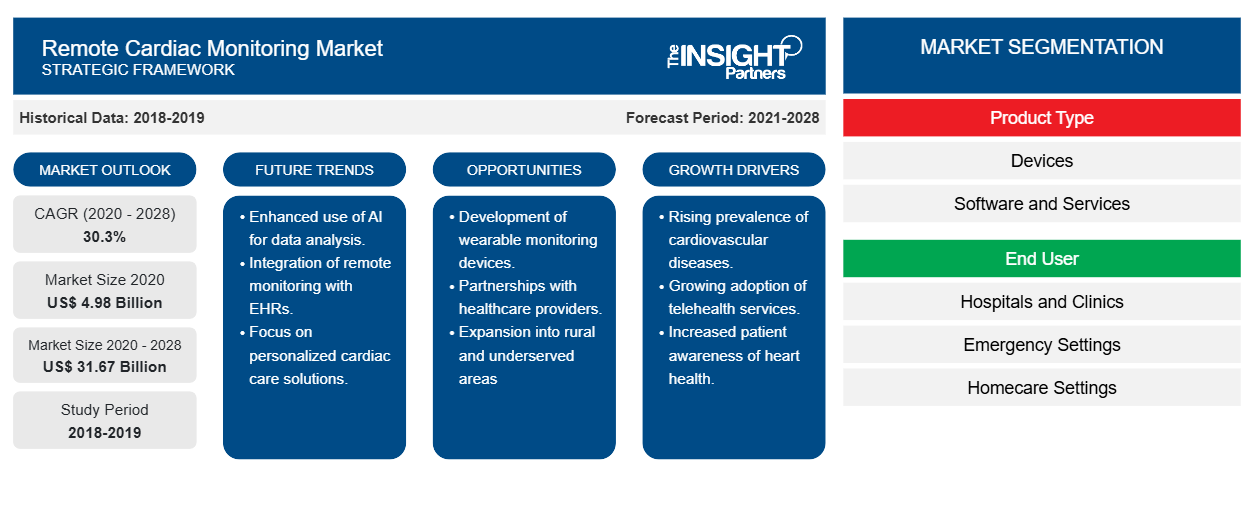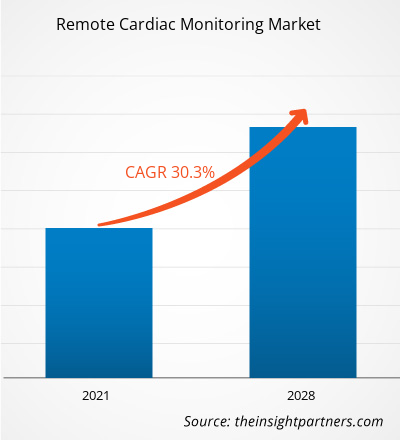Remote Cardiac Monitoring Market Size and Competitive Analysis by 2028
Historic Data: 2018-2019 | Base Year: 2020 | Forecast Period: 2021-2028Remote Cardiac Monitoring Market Forecast to 2028 - COVID-19 Impact and Global Analysis By Product Type (Devices, Software and Services); End User (Hospitals and Clinics, Emergency Settings, Homecare Settings and Others), and Geography
- Report Date : Sep 2021
- Report Code : TIPRE00024441
- Category : Life Sciences
- Status : Published
- Available Report Formats :


- No. of Pages : 205
The remote cardiac monitoring market is projected to reach US$ 31,671.69 million by 2028 from US$ 4,976.40 million in 2021; it is estimated to grow at a CAGR of 30.3% from 2021 to 2028.
Remote cardiac monitoring devices enable a continuous monitoring of electrical activities of heart away from hospitals. They also allow the at-home electrocardiographic (ECG) monitoring of patients with suspected cardiac arrhythmias or at risk for developing arrhythmias. The monitoring can also be performed when patients are engulfed in their day-to-day activities. Thus, one of the most important benefits of remote cardiac device monitoring is it decreases the need for routine doctor visits. Devices such as pacemakers and implantable cardioverter-defibrillator are implanted in the heart of the patients through minimally invasive procedures. A transmitter that works in sync with the device undertakes the transmission of data. Factors such as increase in the incidence of cardiovascular diseases (CVDs) and continuous developments in the telemedicine approach boost the growth of the remote cardiac monitoring market. However, the concerns regarding data privacy hamper the market growth.
Customize This Report To Suit Your Requirement
You will get customization on any report - free of charge - including parts of this report, or country-level analysis, Excel Data pack, as well as avail great offers and discounts for start-ups & universities
Remote Cardiac Monitoring Market: Strategic Insights

-
Get Top Key Market Trends of this report.This FREE sample will include data analysis, ranging from market trends to estimates and forecasts.
Market Insights
Increase in Incidence of Cardiovascular Diseases
Remote patient monitoring (RPM) allows patients to manage their health better by increasing their involvement in their health care. The American Heart Association supports initiatives to incentivize the design and use of evidence-based remote patient monitoring technologies. According to the World Health Organization (WHO), cardiovascular diseases (CVDs) are among the leading causes of death worldwide, and ~30 million people experience a stroke each year. According to the American Heart Association, almost half of all adults in the US have a type of CVD. Furthermore, more than 130 million people, i.e., 45.1% of the US population, are projected to have a type of CVD by 2035. According to reports by the European Society of Cardiology, CVDs cause 3.9 million deaths in Europe and over 1.8 million deaths in the European Union (EU). Moreover, they account for 45% of all deaths in Europe and 37% of total deaths in the EU. Mortalities caused by CVDs in the Asia-Pacific countries range from less than 20% in countries such as Thailand, the Philippines, and Indonesia to 20–30% in urban China, Hong Kong, Japan, Korea, and Malaysia. Furthermore, New Zealand, Australia, and Singapore, among others, have relatively high rates of 30–35%.
Hypertension is a significant risk factor for CVDs. The age-adjusted prevalence of hypertension among adults in the US is ~35%, equaling the population of ~85 million. By 2035, ~42% of adults from the country, i.e., an additional 27 million, would have this condition. The cost burden of hypertension on economies is also rising, and the costs are likely to soar from ~US$ 70 billion in 2015 to ~US$ 150 billion by 2035. Remote patient monitoring may serve as a vital conduit for improving hypertension control and reducing the economic burden stemming from prolonged or frequent hospital stays that result from acute hypertension-related events. Research has shown that (Remote Patient Monitoring) RPM can significantly lower systolic blood pressure (SBP) and diastolic blood pressure (DBP) compared to usual care and self-monitoring alone. According to a few non-randomized trials, RPM devices can improve outcomes by enabling accurate and early detection as well as decreasing all-cause mortality rates and hospitalizations. Recent clinical guidelines strongly recommend the use of RPM for atrial fibrillation (AF) detection in both stroke and non-stroke patients.
Product Type-Based Insights
Based on product type, the remote cardiac monitoring market is further segmented into devices, software and services. The devices segment held a larger market share in 2021 and is expected to register a higher CAGR during the forecast period.
End User-Based Insights
Based on end user, the remote cardiac monitoring market is segmented into hospitals and clinics, emergency settings, homecare settings, and others. The hospitals and clinics segment would hold the largest market share in 2021, whereas the market for the emergency settings segment is expected to grow at a CAGR of 31.60% during the forecast period.
Various companies operating in the remote cardiac monitoring market are adopting strategies such as product launches, mergers and acquisitions, collaborations, product innovations, and product portfolio expansions to expand their footprint worldwide, maintain brand name, and meet the growing demand from end users.
Remote Cardiac Monitoring Market Regional InsightsThe regional trends and factors influencing the Remote Cardiac Monitoring Market throughout the forecast period have been thoroughly explained by the analysts at The Insight Partners. This section also discusses Remote Cardiac Monitoring Market segments and geography across North America, Europe, Asia Pacific, Middle East and Africa, and South and Central America.
Remote Cardiac Monitoring Market Report Scope
| Report Attribute | Details |
|---|---|
| Market size in 2020 | US$ 4.98 Billion |
| Market Size by 2028 | US$ 31.67 Billion |
| Global CAGR (2020 - 2028) | 30.3% |
| Historical Data | 2018-2019 |
| Forecast period | 2021-2028 |
| Segments Covered |
By Product Type
|
| Regions and Countries Covered |
North America
|
| Market leaders and key company profiles |
|
Remote Cardiac Monitoring Market Players Density: Understanding Its Impact on Business Dynamics
The Remote Cardiac Monitoring Market is growing rapidly, driven by increasing end-user demand due to factors such as evolving consumer preferences, technological advancements, and greater awareness of the product's benefits. As demand rises, businesses are expanding their offerings, innovating to meet consumer needs, and capitalizing on emerging trends, which further fuels market growth.

- Get the Remote Cardiac Monitoring Market top key players overview
Remote Cardiac Monitoring Market – by Product Type
- Devices
- Software
- Services
Remote Cardiac Monitoring Market – by End User
- Hospitals and Clinics
- Emergency Settings
- Homecare Settings
- Others
Remote Cardiac Monitoring Market – by Geography
- North America
- US
- Canada
- Mexico
- Europe
- France
- Germany
- Italy
- UK
- Spain
- Rest of Europe
- Asia Pacific (APAC)
- China
- India
- South Korea
- Japan
- Australia
- Rest of Asia Pacific
- Middle East & Africa (MEA)
- South Africa
- Saudi Arabia
- UAE
- Rest of Middle East & Africa
- South & Central America (SCAM)
- Brazil
- Argentina
- Rest of South and Central America
Company Profiles
- OSI Systems, Inc.
- GE Healthcare
- Biotronik Se
- Nihon Kohden Corporation
- Abbott Laboratories
- Boston Scientific Corporation
- Koninklijke Philips N.V.
- Honeywell International, Inc.
- AMC Health
Frequently Asked Questions
What is the regional market scenario of remote cardiac monitoring?
Who are the key players in the remote cardiac monitoring market?
Which end-user held the largest share in the remote cardiac monitoring market?
Which product type led the remote cardiac monitoring market?
What is remote cardiac monitoring?
What are the driving factors for the remote cardiac monitoring market across the globe?
Mrinal is a seasoned research analyst with over 8 years of experience in Life Sciences Market Intelligence and Consulting. With a strategic mindset and unwavering commitment to excellence, she has built deep expertise in pharmaceutical forecasting, market opportunity assessment, and developing industry benchmarks. Her work is anchored in delivering actionable insights that empower clients to make informed strategic decisions.
Mrinal’s core strength lies in translating complex quantitative datasets into meaningful business intelligence. Her analytical acumen is instrumental in shaping go-to-market (GTM) strategies and uncovering growth opportunities across the pharmaceutical and medical device sectors. As a trusted consultant, she consistently focuses on streamlining workflow processes and establishing best practices, thereby driving innovation and operational efficiency for her clients.
- Historical Analysis (2 Years), Base Year, Forecast (7 Years) with CAGR
- PEST and SWOT Analysis
- Market Size Value / Volume - Global, Regional, Country
- Industry and Competitive Landscape
- Excel Dataset
Recent Reports
Testimonials
The Insight Partners' SCADA System Market report is comprehensive, with valuable insights on current trends and future forecasts. The team was highly professional, responsive, and supportive throughout. We are very satisfied and highly recommend their services.
RAN KEDEM Partner, Reali Technologies LTDsI requested a report on a very specific software market and the team produced the report in a few days. The information was very relevant and well presented. I then requested some changes and additions to the report. The team was again very responsive and I got the final report in less than a week.
JEAN-HERVE JENN Chairman, Future AnalyticaWe worked with The Insight Partners for an important market study and forecast. They gave us clear insights into opportunities and risks, which helped shape our plans. Their research was easy to use and based on solid data. It helped us make smart, confident decisions. We highly recommend them.
PIYUSH NAGPAL Sr. Vice President, High Beam GlobalThe Insight Partners delivered insightful, well-structured market research with strong domain expertise. Their team was professional and responsive throughout. The user-friendly website made accessing industry reports seamless. We highly recommend them for reliable, high-quality research services
YUKIHIKO ADACHI CEO, Deep Blue, LLC.This is the first time I have purchased a market report from The Insight Partners.While I was unsure at first, I visited their web site and felt more comfortable to take the risk and purchase a market report.I am completely satisfied with the quality of the report and customer service. I had several questions and comments with the initial report, but after a couple of dialogs over email with their analyst I believe I have a report that I can use as input to our strategic planning process.Thank you so much for taking the extra time and making this a positive experience.I will definitely recommend your service to others and you will be my first call when we need further market data.
JOHN SUZUKI President and Chief Executive Officer, Board Director, BK TechnologiesI wish to appreciate your support and the professionalism you displayed in the course of attending to my request for information regarding to infectious disease IVD market in Nigeria. I appreciate your patience, your guidance, and the fact that you were willing to offer a discount, which eventually made it possible for us to close a deal. I look forward to engaging The Insight Partners in the future, all thanks to the impression you have created in me as a result of this first encounter.
DR CHIJIOKE ONYIA MANAGING DIRECTOR, PineCrest Healthcare Ltd.Reason to Buy
- Informed Decision-Making
- Understanding Market Dynamics
- Competitive Analysis
- Identifying Emerging Markets
- Customer Insights
- Market Forecasts
- Risk Mitigation
- Boosting Operational Efficiency
- Strategic Planning
- Investment Justification
- Tracking Industry Innovations
- Aligning with Regulatory Trends




















 Get Free Sample For
Get Free Sample For